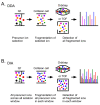Quantitative Mass Spectrometry-Based Proteomics for Biomarker Development in Ovarian Cancer
- PMID: 34063568
- PMCID: PMC8125593
- DOI: 10.3390/molecules26092674
Quantitative Mass Spectrometry-Based Proteomics for Biomarker Development in Ovarian Cancer
Abstract
Ovarian cancer is the most lethal gynecologic malignancy among women. Approximately 70-80% of patients with advanced ovarian cancer experience relapse within five years and develop platinum-resistance. The short life expectancy of patients with platinum-resistant or platinum-refractory disease underscores the need to develop new and more effective treatment strategies. Early detection is a critical step in mitigating the risk of disease progression from early to an advanced stage disease, and protein biomarkers have an integral role in this process. The best biological diagnostic tool for ovarian cancer will likely be a combination of biomarkers. Targeted proteomics methods, including mass spectrometry-based approaches, have emerged as robust methods that can address the chasm between initial biomarker discovery and the successful verification and validation of these biomarkers enabling their clinical translation due to the robust sensitivity, specificity, and reproducibility of these versatile methods. In this review, we provide background information on the fundamental principles of biomarkers and the need for improved treatment strategies in ovarian cancer. We also provide insight into the ways in which mass spectrometry-based targeted proteomics approaches can provide greatly needed solutions to many of the challenges related to ovarian cancer biomarker development.
Keywords: biomarker; mass spectrometry; ovarian cancer; proteomics.
Conflict of interest statement
The authors declare no conflict of interest.
Figures


Similar articles
-
A Targeted Mass Spectrometry Strategy for Developing Proteomic Biomarkers: A Case Study of Epithelial Ovarian Cancer.Mol Cell Proteomics. 2019 Sep;18(9):1836-1850. doi: 10.1074/mcp.RA118.001221. Epub 2019 Jul 9. Mol Cell Proteomics. 2019. PMID: 31289117 Free PMC article.
-
Novel proteomic technologies to address gaps in pre-clinical ovarian cancer biomarker discovery efforts.Expert Rev Proteomics. 2023 Jul-Dec;20(12):439-450. doi: 10.1080/14789450.2023.2295861. Epub 2023 Dec 30. Expert Rev Proteomics. 2023. PMID: 38116719 Review.
-
Proteomics of ovarian cancer: functional insights and clinical applications.Cancer Metastasis Rev. 2015 Mar;34(1):83-96. doi: 10.1007/s10555-014-9547-8. Cancer Metastasis Rev. 2015. PMID: 25736266 Free PMC article. Review.
-
Ovarian cancer circulating extracelluar vesicles promote coagulation and have a potential in diagnosis: an iTRAQ based proteomic analysis.BMC Cancer. 2019 Nov 12;19(1):1095. doi: 10.1186/s12885-019-6176-1. BMC Cancer. 2019. PMID: 31718609 Free PMC article.
-
Profiling signatures of ovarian cancer tumour suppression using 2D-DIGE and 2D-LC-MS/MS with tandem mass tagging.J Proteomics. 2011 Apr 1;74(4):451-65. doi: 10.1016/j.jprot.2010.12.009. Epub 2011 Jan 13. J Proteomics. 2011. PMID: 21237297
Cited by
-
Research progress of extracellular vesicles in the treatment of ovarian diseases (Review).Exp Ther Med. 2023 Nov 15;27(1):15. doi: 10.3892/etm.2023.12303. eCollection 2024 Jan. Exp Ther Med. 2023. PMID: 38125352 Free PMC article. Review.
-
Mass Spectrometry-Based Proteomics of Epithelial Ovarian Cancers: A Clinical Perspective.Mol Cell Proteomics. 2023 Jul;22(7):100578. doi: 10.1016/j.mcpro.2023.100578. Epub 2023 May 19. Mol Cell Proteomics. 2023. PMID: 37209814 Free PMC article. Review.
-
The Molecular Landscape Influencing Prognoses of Epithelial Ovarian Cancer.Biomolecules. 2021 Jul 7;11(7):998. doi: 10.3390/biom11070998. Biomolecules. 2021. PMID: 34356623 Free PMC article. Review.
-
Early Diagnosis of Ovarian Cancer: A Comprehensive Review of the Advances, Challenges, and Future Directions.Diagnostics (Basel). 2025 Feb 7;15(4):406. doi: 10.3390/diagnostics15040406. Diagnostics (Basel). 2025. PMID: 40002556 Free PMC article. Review.
-
Recent advances in mass spectrometry-based proteomics and metabolomics in chronic rhinosinusitis with nasal polyps.Front Immunol. 2023 Sep 6;14:1267194. doi: 10.3389/fimmu.2023.1267194. eCollection 2023. Front Immunol. 2023. PMID: 37744372 Free PMC article. Review.
References
-
- Roett M.A., Evans P. Ovarian Cancer: An Overview. Am. Fam. Physician. 2009;80:609–616. - PubMed
-
- Thomson C., Caan B. Optimizing Women’s Health through Nutrition. Volume 60. Apple Academic Press; Palm Bay, FL, USA: 2007. Breast and Ovarian Cancer; pp. 229–263.
Publication types
MeSH terms
Substances
Grants and funding
LinkOut - more resources
Full Text Sources
Other Literature Sources
Medical

